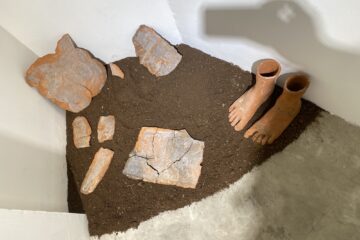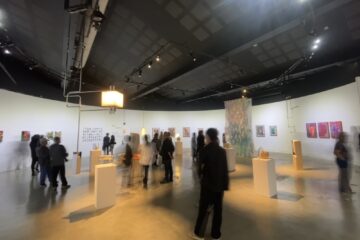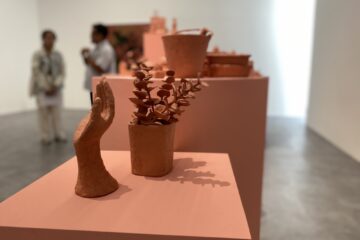This exhibition is an echo chamber for the voiceless. They whisper a shared message: silenced wounds never die; they become ghosts that haunt the table of history.
Two dancers, a man and a woman, step onto a round table. Accompanied by the iconic Indonesian cha-cha melodies of the 1970s, their bodies begin to move. Their gestures appear joyful yet carry an undertone of a plea to suppressed memories and restrained longing. Unbeknownst to the audience, each stomp of their feet is more than just dance. The dancers are pressing carved wooden blocks, gradually creating an artwork on a cotton canvas hidden beneath their soles.
Once the dance concludes, the table is unveiled, revealing a graphic print on the cotton fabric. Its imagery mirrors the graphic artwork displayed on the stage’s backdrop, a piece on brocade titled Bu Yao Wang Ji (“Don’t Forget” in Indonesian). The figure in this work is enigmatic. Up close, its form is vague, but from a distance, the image sharpens: a man crouching beside a drainage ditch. This figure instantly evokes the likeness of Indonesia’s seventh president, Joko Widodo.
Agung Kurniawan, the artist behind the work, explains that this graphic piece portrays a post-1998 Reformation-era Indonesian president—a leader expected to be of the people, not from military ranks, and chosen through democratic processes. Yet, over time, this leader disappointed the hopes of those who once supported him. Agung himself was once a supporter. As time passed, he chose to step back for a clearer perspective, and from that distance, his disillusionment grew. Bu Yao Wang Ji embodies this sentiment.
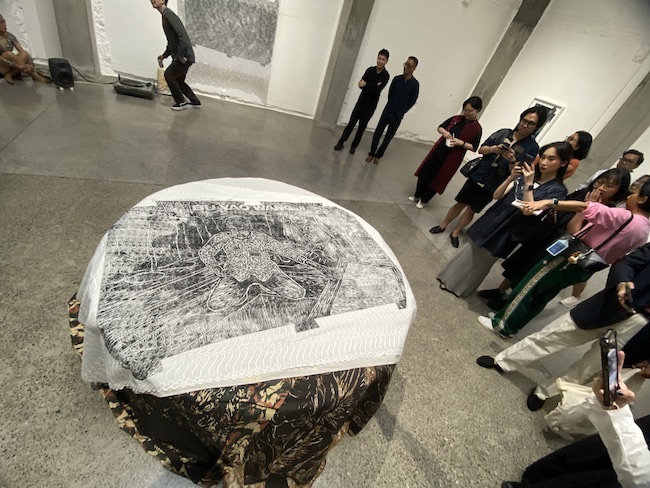
After the artwork beneath the table is revealed, the dancers’ performance transcends mere dance. It becomes a metaphor for an artistic process that resists collective amnesia. They dance against the tide of negotiated realities in an era of misinformation. Their movements seem to declare that refusing to forget requires a kinetic reminder—alive and in motion. And so it is: an image born beneath meaningful footfalls.
This performance opens Agung Kurniawan’s solo exhibition at ROH Gallery, Jakarta, titled Whoever Stays Until The End Will Tell The Story, held from August 2 to September 7, 2025. The exhibition showcases Agung Kurniawan’s (also known as Agung Leak) long-term project, meticulously developed over more than a decade. His older works engage dynamically with new pieces created specifically for this exhibition, weaving sharp allegories around faith, betrayal, hope, and sacrifice.
The exhibition unfolds like a novel, divided into evolving chapters, each giving voice to a different protagonist. Through this narrative lens, visitors are invited to explore how Indonesian history is told—and, more crucially, what remains untold—through the voices of the living and the departed.
The exhibition unfolds like a novel, divided into evolving chapters, each giving voice to a different protagonist.
Before entering the main gallery, visitors are greeted by an arresting installation in the front courtyard. A series of reliefs scatters across a gray cement wall, serving as the exhibition’s prologue. Iron grid lines form vivid images through shadow play: in the midday sun, the shadows nearly vanish, camouflaged, but at dusk, natural light gives way to spotlights, creating illusions of double or triple images.
One relief casts the shadow of Agung’s brother, who disappeared during an adventure. Other images emerge like mirages: a man on a motorcycle, a fictional female biker gang leader gripping a sword, or children in a pedicab being pulled along. At this threshold, visitors face fundamental questions: What do we truly see? What is deliberately or unintentionally hidden? How do we look, and why are some things shown while others are ignored? These philosophical inquiries linger, priming the mind before the formal gallery experience begins.
A Hardening Political Metaphor
Upon entering the gallery, the eye is drawn to a wall filled with human faces. This is the Pontius Pilatus Syndrome series (2012–2025), a collection of colorful soap reliefs depicting the faces of five marginalized figures from various regimes: Munir, Udin, Marsinah, Trubus, and Wiji Thukul.
Shockingly, these faces are not intact. Some are eroded by mold, others gnawed by rodents, and some decayed by time. Over the decade-long development of this work, the soap sculptures were deliberately left to deteriorate: overtaken by greenish mold, eaten by insects, or destroyed by rats. This decay becomes a haunting visual metaphor. Shriveled mouths, split or severed heads—all crystallize an allegory of silenced voices and severed thoughts.

Beyond its form and material, the work’s title carries a vital theological layer. Pontius Pilate, the Roman governor in the Gospel of Matthew who washed his hands before the crowd, symbolizes the denial of responsibility for Jesus’ crucifixion. The soap, meant to cleanse, becomes paradoxical: instead of purifying, it rots and is tainted by mold, its antithesis.
Here, the political metaphor solidifies. The degradation of the activists’ faces on the “tainted” soap mirrors the government’s stance in their disappearances. Like Pilate, power seems intent on washing its hands. Every cavity gnawed by rats, every layer of mold obscuring the statues’ eyes, serves as a reminder that neglect leaves indelible traces.
The degradation of the activists’ faces on the “tainted” soap mirrors the government’s stance in their disappearances. Like Pilate, power seems intent on washing its hands.
Pontius Pilatus Syndrome confronts the Sri Serie, Agung’s longest-running memory project, featuring five variations of 65 identical images. These are not mere static portraits but living archives that breathe through audience participation. Since 2017, each iteration of this series has involved 65 participants, each holding a single image. Under Agung’s direction, they feel the memory embedded in the paper, then recite a secret word on its back with synchronized volume, rhythm, and intonation. These fragmented utterances merge into a constellation of sound, weaving meaning across space and time.
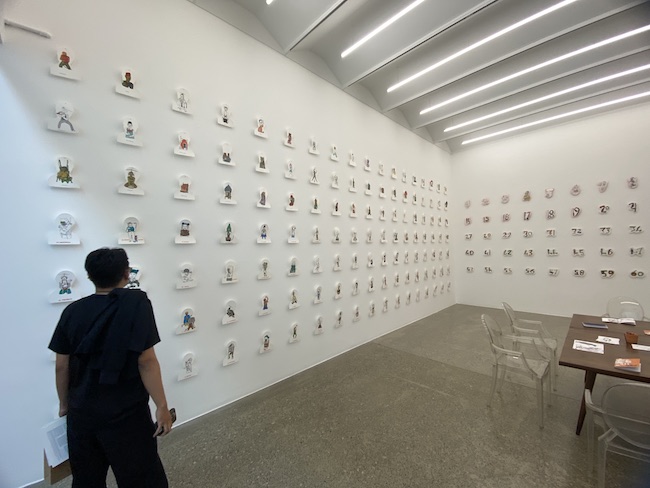
Now displayed in a neat, symmetrical grid, these portraits feel deceptively light. Their rainbow hues seem to deny the complexity behind each silhouette: the tangled, burdened shadows of memory tied to the 1965 massacres, a still-open national wound.
In the same room, a participatory installation awaits at the gallery’s center: a long table inviting visitors to sit and open The Guest, a picture book with deliberately blank pages. Its visual narrative repeats three characters: a mysterious hooded bear, a curious child, and a monster that sneaks in and devours their possessions.
These books are not passive objects. They serve as a stage for collective imagination. Visitors are encouraged to fill the empty lines with their own stories and color the black-and-white illustrations. Here, coloring becomes a symbolic ritual: how do you bring color to a moment of “dining” with monsters and beasts?
Proliferating Sacred Allegories
In the transitional space between the Apple and Orange Galleries, Agung’s The Last Dance creates a moving meditation: clothing from 1965 tragedy survivors rotates slowly clockwise. These technicolor fabrics, with their varied textures, form a dance where vibrant colors belie the dark nostalgia woven into each thread. Only upon examining the stitches and material layers does a sense of loss strike: the unspoken scars of history.
Accompanied by a sound composition by Sri Wahyuni (a key figure in Sri Serie), this installation creates a dialogue between victims of two eras. The Last Dance evokes a biblical parallel: just as touching Christ’s robe brought healing through faith in the Gospels, this work becomes a medium for a “miracle” of memory, reviving belief in a history stolen.
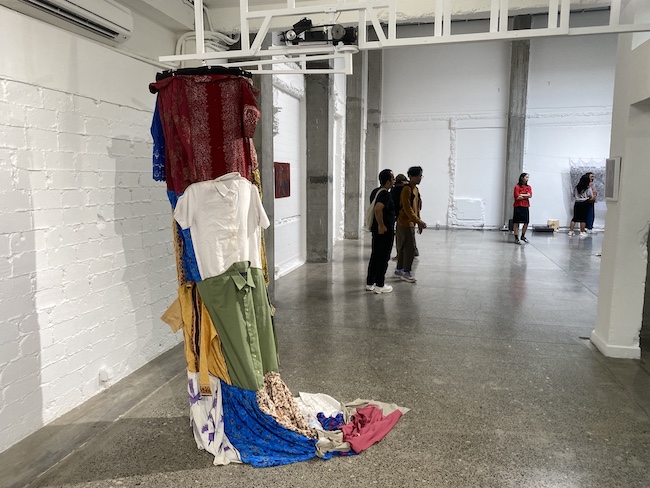
One might say this exhibition reaffirms Agung Kurniawan’s return to sacred allegory as a moral framework. As curator Mira Asriningtyas explores in her essay, Agung condenses Indonesian historical figures into a theological structure—not as doctrine but as a strategy of sign-play to map the mechanisms of collective forgetting.
Consider his paintings: human bodies fold into nightmarish architecture, wavy roofs morph into shoulder blades, latrine doors split torsos. In Agung’s imagined world, time floats, and bodies must be deconstructed to survive on the allegorical stage. Power carves bodies into costumes, and the stage is always stained with the copper-red of blood.
These sacred allegories intertwine: from Pontius Pilatus Syndrome (the hand-washing ruler), to The Man Risen from the Grave (Judas’ embrace marked by stigmata), to The Last Dance (the ironic healing robe). This repetition reactivates awareness. In a world of fragmented memory and unresolved truths, Agung Kurniawan offers a weapon: the return of allegory as a form of warning.
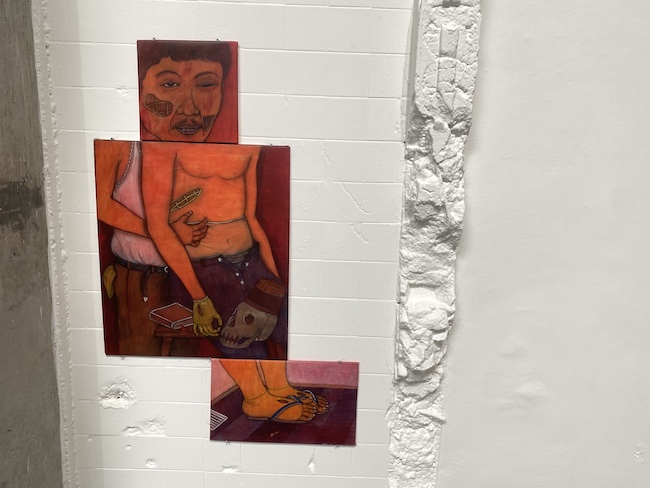
Ultimately, this exhibition is an echo chamber for the voiceless. They whisper a unified message: silenced wounds never die; they become ghosts circling the table of history. In this gallery, collective memory is no longer reliant on complete facts but is pieced together from fragments, wounds, and imposed untruths.
Rather than a mere title, Whoever Stays Until The End Will Tell The Story is a method—a testimony that those who endure will uncover the hidden stories behind the dance, soap, and shadows that never truly fade.
To endure here means to join the dance, to become the dancer whose feet press wounds until they speak, the listener whose soul is torn to piece together story fragments, and the witness who understands that every surface we tread may conceal a canvas of truth. In the end, those who persevere will tell their truth.
- Cover imager: Hidayat Adhiningrat
- Dancing on the Grave of Severed Memories - September 30, 2025
- The Magic of Objects in Stillness - September 30, 2025
- The Storytelling Soil - September 30, 2025


